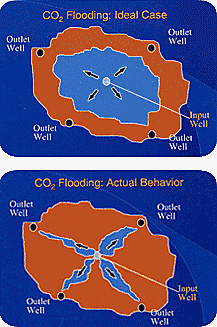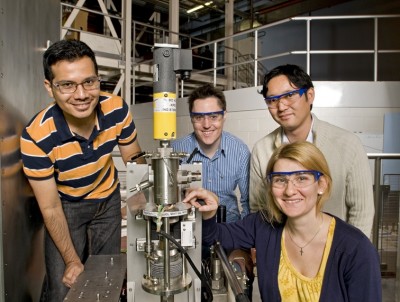Nov
29
Making CO2 Better for Oil Extraction
November 29, 2010 | 4 Comments
Researchers have developed a soap-like additive for CO2 that turns it into a viable solvent for commercial-scale enhanced oil recovery to increase the amount of crude oil that can be extracted from oil fields. This might be a major step in oil field recovery, which could vastly expand the world reserves.

University of Pittsburg's Oil Flood Ideal vs Actual Using CO2 Additive. See text for the Pitt link below.
CO2 offers an efficient, cheap, non-toxic, non-flammable and environmentally responsible alternative to conventional petrochemical solvents. Even water as a solvent for example, comes with its own set of problems; after being used to flush out oil from rocks it then requires cleaning before it can be used again, whereas liquid CO2 can be re-used immediately.
Bristol’s Professor Julian Eastoe explains saying, “Carbon dioxide is useful in enhanced oil recovery as it is able to flow through the pores in the rock much more easily than water. The additive, a surfactant, will help thicken the carbon dioxide, which is vital for this process, allowing it to flow through the rock more efficiently. There is also a useful side effect of our ability to use CO2 in this way, as in the future the process will take carbon dioxide generated by industrial activity from atmosphere dumping and lock it deep underground. Getting longer life out of existing oil reserves will also give more time for research into replacements into non-carbon energy sources such as solar or hydrogen.”
The additives have other uses as well; they can also be used to reduce the environmental damage caused by every day industrial processes such as food processing and the manufacture of electronics. The scientific paper was published in the journal Langmuir.
The news release has made a significant splash in the UK. Minister for Science and Universities David Willetts said, “This shows what science can do for the environment. It’s why the Government has protected the science budget. In particular it shows how financing core science facilities can lead to many different projects with valuable applications.”
Meanwhile there is an industrial trend, liquid CO2 is increasingly being used to replace common petrochemical solvents because it requires less processing and it can be easily recycled. The difficulty has been that in order to operate effectively as a solvent, carbon dioxide needs additives, many of which are in themselves, damaging to the environment.
Pitt’s Bob Enick said, “The quest to find a chemical capable of modifying the properties of CO2 to make it suitable for widespread use as a solvent in enhanced oil recovery has been long. Previous advances have involved surfactants containing fluorine, which although highly soluble in CO2, are very environmentally damaging. The new additive, surfactant TC14, contains no fluorine at all and is a harmless hydrocarbon.”
The new additive, a surfactant named TC14, enables small pockets to form in the liquid CO2 called reverse micelles causing the liquid to thicken. Neutron scattering at ISIS allowed the structure of the reverse micelles to be studied in the CO2 as they formed under high pressure. The neutron instruments giving this molecular level viewpoint are often described as ‘super-microscopes’.
ISIS scientist Dr Sarah Rogers explains, “Beams of neutrons are able to penetrate deep inside samples giving unique information about the location and arrangement of the micelles at a molecular level. By altering the pressure in a specially constructed experimental cell, dissolved material can easily be separated and removed leaving the carbon dioxide for the next use. It would be difficult to look at this system using any other technique, as the CO2 needs to be kept under high pressure. Only under the scrutiny of neutron beams can you fully reveal its actions and properties.”
Professor Eastoe sums it up, “Experiments on Sans2d are particularly fast and accurate in comparison to some older neutron scattering instruments. This development of neutron instrument technology is part of what makes ISIS a world leading science facility.”
The international team includes the scientists from Bristol University led by Professor Julian Eastoe, the University of Pittsburgh led by Professor Bob Enick and ISIS scientists Dr Sarah Rogers and Dr Richard Heenan. The project has been funded by the UK Engineering and Physical Sciences Research Council (EPSRC) and the US Department of Energy to explore using high pressure CO2 to extract residual oil retained in the pores of rock.
Just how well the new surfactant for CO2 works in the field is yet to be tested. The cost of the fieldwork with all the CO2 and the materials isn’t known. But with a long list of oil fields with something on the order of 3 to 4 times the amount of oil used in history yet to be recovered and oil prices on the high side, the new technology surely has great economic legs.
Comments
4 Comments so far



[…] This post was mentioned on Twitter by Consilium Advisers and Expansion Media, Cleantech News. Cleantech News said: Making CO2 Better for Oil Extraction: (Source: New Energy and Fuel) Researchers have developed a soap-like addit… http://bit.ly/eG0wJu […]
This has huge potential for countries such as Mexico, the Persian Gulf states, and all the national oil companies whose recovery factor has been poor in some very big oil fields.
Some oil fields recover as little as 10% of oil in place. Few of the larger fields do better than 30%. Doubling of recovery makes the wells’ proved reserves twice as big, in essence.
Americans are doing better because they have to. The US keeps milking significant amounts of oil from fields that were declared dead decades ago. Enhanced recovery is one of the cheapest ways to get more oil.
[…] busca vivo o muerto #1121Re: AGW Denial, The Greatest Scam in History?Just now Nov 29 2010 Making CO2 Better for Oil Extraction November 29, 2010 Researchers have developed a soap-like additive for CO2 that turns it into a […]
constantly i used to read smaller articles that
as well clear their motive, and that is also happening with this paragraph which I am reading at this
time.